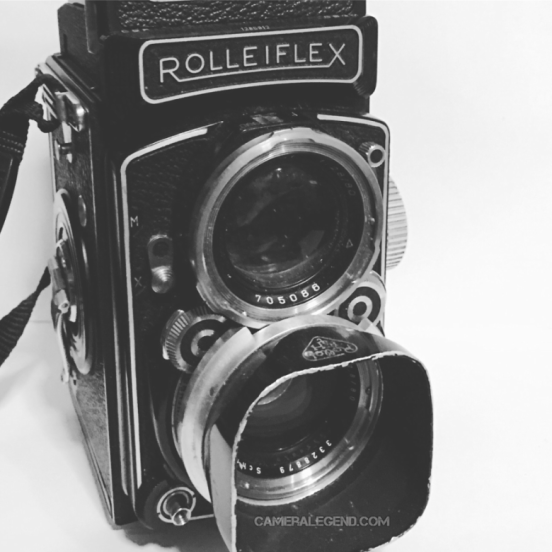
The Rolleiflex 2.8C is a medium format, twin lens reflex camera introduced in 1952 by Franke & Heidecke, aka Rollei GmbH of Germany. The camera produces 6×6 square format images on 120 film.
Although the last remnants of Rollei as we know it vanished completely in 2015, it was and is considered one of the greatest names in photography. Rollei made many, many great and iconic cameras, but their TLR cameras are where they made their name. Today we look at one of their many standout models, the Rolleiflex 2.8C twin lens reflex camera.
UPDATE: One of our readers kindly pointed out that “Rollei” still makes digital medium format cameras.
I’m glad to know this, although I do stand by my statement of the Rollei “as we know it” being gone. However, if the folks running Rollei now can return it to its glory, I’ll be the happiest guy here! Thanks for the information!
ROLLEIFLEX 2.8C INTRODUCTION
If I could only have one camera, it would probably have to be my venerable Rolleiflex 2.8C with the Schneider Xenotar lens. Introduced around 1952-1953, it was the first Rolleiflex model to feature either the Zeiss Planar or Schneider-Kreuznach Xenotar f/2.8 lenses.
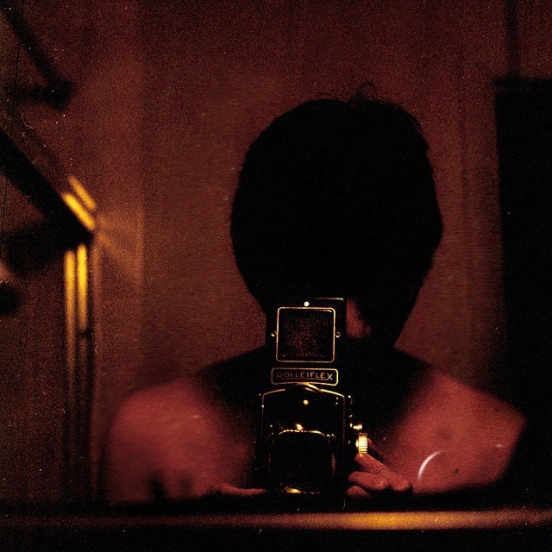
“Diary Of A Mad Man” 2008. Rolleiflex 2.8C, Kodak Portra 400 UC. The Rolleiflex is always ready to shoot…and it’s going to drive you insane man! 🙂
As far as I can tell, the very early versions are known as Type I and only offered the Xenotar lens. The latter version known as Type II offered either the Planar or Xenotar. Keep in mind that “early” and “late” for this camera was only from 1952-1955. I’ve read different accounts that the Planar was offered first and the Xenotar was just a “replacement” lens that were used when production of the Planar was in short supply. I really don’t know and at this point, does it really matter?
It might matter for camera historians, but for shooters either lens I think would be plenty fine regardless of which one came first on the 2.8C model.
Before I go further, I should say that Rolleiflexes have a large and passionate following around the world with many, many Rollei experts out there. I do not consider myself one of those experts. I am just an enthusiast who loves Rolleis and Rolleiflexes and have enjoyed using and collecting Rollei items over the years and doing so “under the radar” (until now I guess!) like I’m sure many of you out there.
The camera is over sixty years old and I think there are already some fine reviews out there. In fact, I’ve decided that I have much more fun giving you a “review” through my impressions and experiences rather than writing a long, formal review. I do try to give you everything I think you might need to know, but I might miss a thing or two. As always I encourage my readers to do more research if they’re really interested. That “search” bar will do you wonders 🙂
With that said, if you are new to TLR photography then I suggest you go and try one out. It doesn’t need to be a Rolleiflex. I could try and explain it, but it will be nowhere as helpful as actually handling a TLR.
This article focuses on the 2.8C model specifically. You will be fine with any of the Rolleiflex 2.8 series, A/B/C/D/E/F…you have lots of choices!
AS A CAMERA
Back to the Rolleiflex 2.8C…Why do I love it? Simple, it always delivers the goods. It’s got a great lens and doesn’t need batteries to operate. I got it used, in bargain condition in 2008. It has never had a CLA, though I think a CLA is long overdue. Keep in mind that the Rollei has a mechanical shutter and that is always going to be less accurate than an electronically timed shutter, so if you feel the speeds are way off, get a CLA.

“Morning Fuel” 2008. Rolleiflex 2.8C, 80mm f/2.8 Xenotar. Can’t remember the film though it’s most likely Tri-X or Neopan.
The Rolleiflex 2.8C is well built, as are all the top tier Rolleiflexes. The camera weighs roughly 2.5 pounds. It will probably be heavier than a mirrorless with lens, but would weigh less than your mid-level or pro Canon/Nikon body with pro lens. The Rolleiflex is NOT pocketable 🙂
The focus knob is on your left side and the film wind crank is on your right side when the camera is in use. The shutter automatically cocks when you turn the winding crank and pull it back.
Right near the lenses, the aperture control dial will be on your left hand side and the shutter speed control dial on your right hand side. You depress in slightly, then turn. The Rolleiflex 2.8C does not have an EVS system and I consider this an advantage because you need not worry about those dials moving together and you’re free to choose whatever aperture/shutter speed combo you like.
The waist-level finder (WLF) is used for focusing and it snaps into focus nicely. As far as I know, this model is not compatible with the Rollei prism finder, though I never felt the need for one on a TLR. I suppose a skilled technician could modify this, but why bother? The waist-level finder is one of the thrills of TLR photography as far as I’m concerned. If you’re new to TLR photography, the WLF will probably have the biggest initial impact on you.
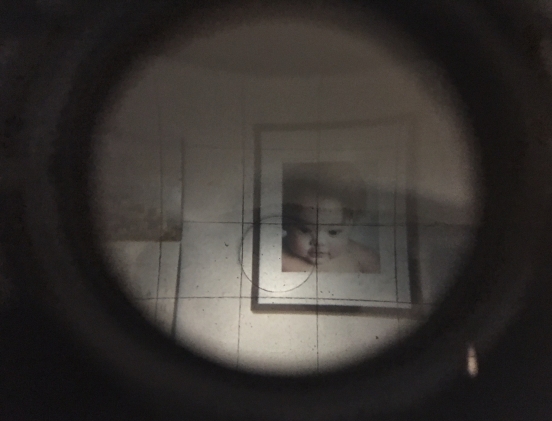
A view through the Rolleiflex waist-level finder.
The camera feels good in the hand with a nice heft to it. I prefer it to the smaller Rolleicords. The camera is sure to get you some looks and maybe start a conversation if used in public enough, it is not unobtrusive or inconspicous in any way 🙂
The camera has a shutter speed range of 1 sec to 1/500 plus Bulb.
NO METER? NO PROBLEM
The 2.8C lacks a meter and I don’t miss it. Truth of the matter is, sticking to ISO 400 film and using meterless cameras for years now, I’ve instinctively come to figuring out the exposures I need without much thought. I do not say this in a braggadocious way. It becomes second nature with time and practice as many photographers can tell you.
I am a firm believer that practicing on a meterless camera will make you a more proficient photographer. Plus black and white film is very forgiving, so unless you’re way off, you should be alright. All of the photos in this article were taken with on the fly metering, without the use of a light meter.
But you can certainly use a handheld meter or download a light meter app on your smartphone. I’m not against meters by any means. I use them on any camera that has one. But if a camera has no meter, I don’t bother using one, it adds to the fun and I learn. I generally do find that many times, manually metering old cameras yields better results for me. Just remember the reading from a meter is just your starting point, not the end word to your exposures.
I have tried the phone apps to check against my digital cameras and they work great. In fact, if you’re used to using a meter, get a meterless camera body, start out with a handheld light meter (old school or phone is ok) and then ween yourself off the meter.
THE XENOTAR LENS
While I hope you can tell from all the cameras profiled here that I am no brand loyalist, you might and probably rightfully so, imagine that I would have preferred the Zeiss Planar. The Zeiss Planar is very well known and quite popular with the masses. In fact, the first Rolleiflex I got years before I got the 2.8C was the 2.8F with the Planar lens, based on reputation of the Zeiss Planar alone.
The truth of the matter though is that while I have used both the 2.8F Planar and the 2.8C Xenotar, I actually prefer the Xenotar.
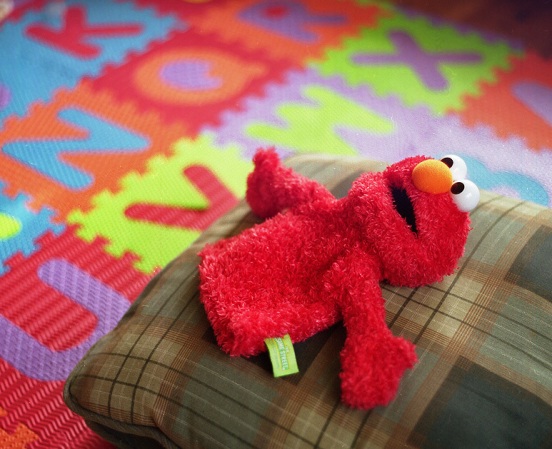
“Tickle Me Elmo” 2008. Rolleiflex 2.8C, 80mm f/2.8 Xenotar lens, Kodak Portra 400. The lens was probably stopped down in between f/3.5-5.6.
The above photo of Elmo may seem a silly way to demonstrate the Xenotar lens, but I think the image shows the vibrant colors and high image definition the Xenotar lens is capable of. Check out Elmo’s nose for a little bit of that micro detail/contrast. The image also shows a little bit of the Xenotar’s bokeh in a disadventageous situation. The Xenotar generally delivers pleasing bokeh, but this may seem a tad busy due to those alphabet tiles. In that respect, it’s actually pretty smooth. I know of many other lenses that would not do as well with that background.
One note, I would love to post larger versions here, but the server here no longer supports that. I did try linking a Flickr account to do that, but it ended up being a tedious process of me editing the links for them to show up correctly. But maybe I’ll try again.
Anyway, while I love the Xenotar, I’m never going to hate on the Planar though so let me just say this was a personal preference based on the two camera samples I had as opposed to something technical about the performance of the lenses. But since I know we all love to read these things, let me say that with these two Rolleiflexes I’ve used, the Xenotar exhibited better perceived sharpness and contrast.
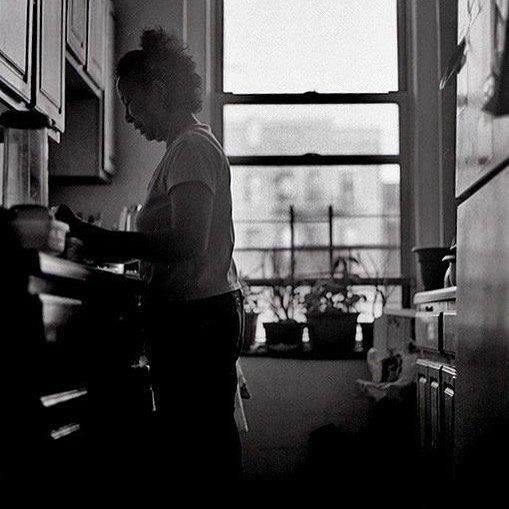
“Mom’s Kitchen” 2009. Rolleiflex 2.8C, 80mm f/2.8 Xenotar lens, Kodak T-Max 400 in T-Max developer. This was shot in 2009, but looks like it could be a scene from any NYC kitchen from the 1950s and up. As a vintage photo fan, the Rolleiflex and b&w is vintage photo heaven.
The Planar was probably just as sharp, but showed lower contrast. This could have been due to sample variation or defects in the lens, ie, cleaning marks, haze, bubbles, separation, etc, though I did not detect any of this by eye inspection. Keep in mind though that both cameras were already at least fifty years old when I compared them.
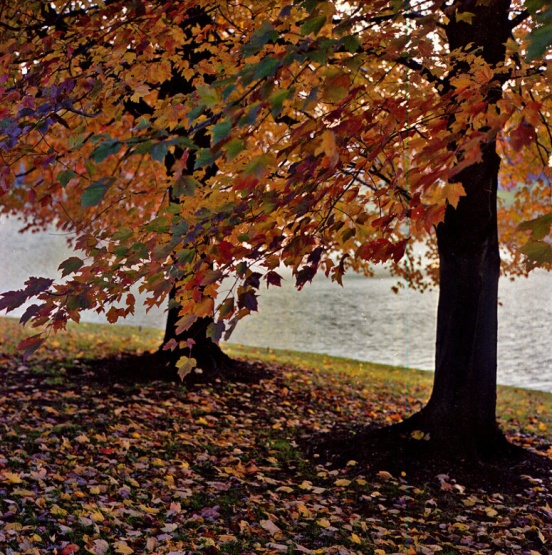
“Fall Back” 2007. Rolleiflex 2.8F, 80mm f/2.8 Planar, Kodak Portra 400 UC. Just a sample shot from the Planar. I would never hate on the Planar, I just like the Xenotar lens better based on my experiences with both lenses. But the soft out of focus areas from the Planar here look quite lovely I think.
Whatever it was, the better sharpness and contrast on my copy of the 2.8C resulted in images with that extra bit of snap to it. This is probably micro details, micro contrast or whatever “micro” you might call it. It adds an extra “pop” to certain images and accentuates that medium format look.
The funny thing is that this “pop” is usually attributed to Zeiss lenses, but in this case it’s not the Zeiss, but the Schneider lens. But Planar fans need not sweat it as the Schneider-Kreuznach (don’t you just love saying that?) Xenotar has been said to be a Planar equivalent or design copy. I have used plenty of Planar type lenses as well as many other Zeiss and Schneider lenses over the years and I can only confirm what others have said…you can’t go wrong with either. Both companies make top notch, world class, and yes, legendary lenses.
NOTES ON BOKEH
One interesting note on the Rolleiflex 2.8C is that the Xenotar on this model has the highly desirable ten aperture blades. That is one of the reasons I settled on the 2.8C. This should result in more rounded, uniform highlights in the out of focus area.
Generally, the Xenotar’s bokeh is smooth and very pleasing. It won’t be super buttery smooth like a modern lens though. You will sometimes get some coma shaped “orbs” in the background, which you see in a lot of vintage lenses. It may not be completely perfect, but I think it actually adds some character to the images. Even modern lenses such as the Canon EOS 85mm f/1.2L exhibit similar characteristics in the bokeh.
The lens does not really do “swirly bokeh” but once in a while, depending on the background, etc, you might see something reminiscent of a swirl I guess.
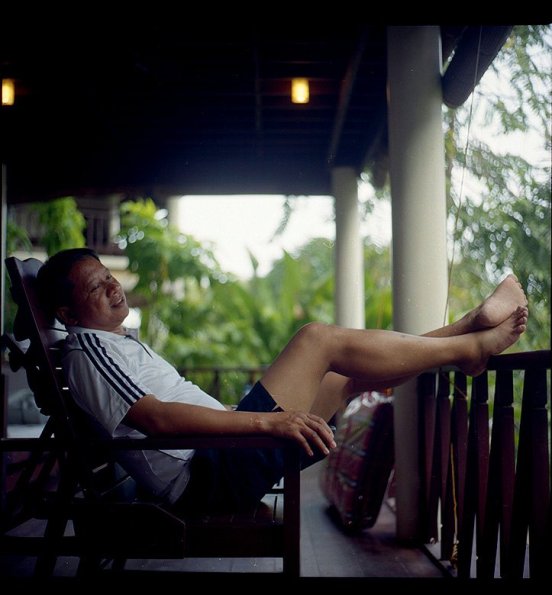
“Schwing” 2011. Rolleiflex 2.8C, 80mm f/2.8 Xenotar, Kodak Ektar 100. This man was super chill in Batangas, Philippines.
I’m not making any excuses for it, though it might sound like that. This is a superb lens, but it is an old lens. It has character and I like it the way it is!
One other interesting tidbit to this is that while the ten blades are indeed desirable, most of the time when people are thinking bokeh, they are also using their lenses wide open in which none of the blades are making an impact on the images. Keep this in mind!
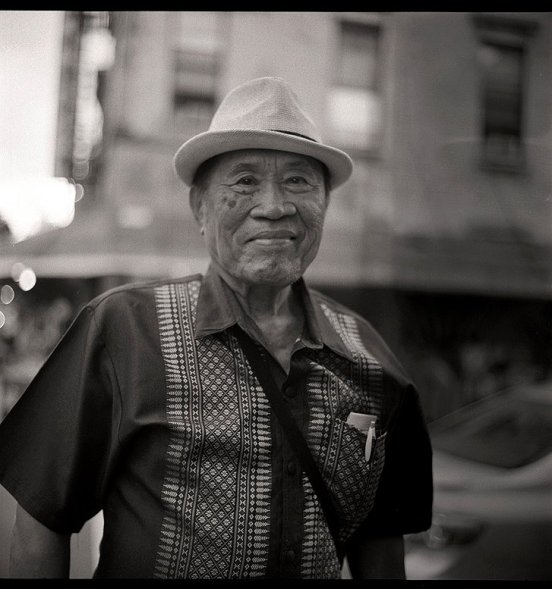
“Gwapo On Grand Street” 2012. Rolleiflex 2.8C, 80mm f/2.8 Xenotar, Fomapan 400 developed in D76. Note the “micro” contrast/details in the hat of this man captured on Grand Street, NYC.

“Madam” 2011. Rolleiflex 2.8C, Kodak Ektar 100, Manila, Philippines.
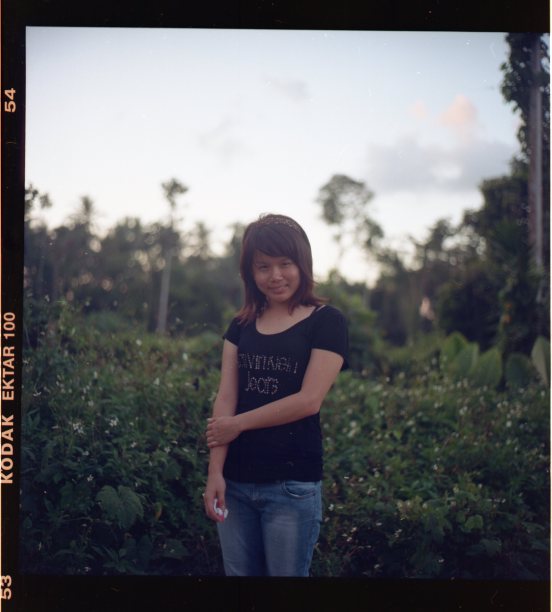
“Nam Tan Wan” 2011. Rolleiflex 2.8C, Kodak Ektar 100, Nakhon Si Thammarat, Thailand. In Thai that means “Sweet Sugar” 🙂

“Lots Of Opposites” 2009. Rolleiflex 2.8C, 80mm f/2.8 Xenotar lens, Kodak T-Max 400 in T-Max Developer. Baby Z holding one of her first reading books. My friends, boy how fast the time flies. Take plenty of pictures and enjoy life for it passes right before your very eye.
As with any lens of this vintage, it would benefit from a lens hood. Rolleiflex 2.8 models take Bay III filters, hoods, etc. I have not generally had too many issues with bad flaring on the Xenotar, but it’s good insurance to have a hood, especially for a vintage lens older than fifty years. Plus the Rollei hood for this camera is just so damn cool! 🙂

“Serene” 2012. Rolleiflex 2.8C, Fomapan 400 in D76. Here’s a closer portrait using the Rolleiflex 2.8C with the Rolleinar II close-up lens. The film used was Fomapan 400. This is a wonderful setup for close but comfortable portraits.
BOTTOM LINE
In the 1990s I read a book called “Medium Format Photography” by the late great Lief Ericksenn and he stated Rollei claimed back in the days of the Rolleiflex: “A roll of film, and our camera and you’re in business.”
With all the camera choices we have these days, that may not ring true on specific terms. But relatively speaking, I still think they could make a case for it. With the 2.8C, you have a well built camera that needs no batteries and has an absolutely stellar lens. You have no gimmicks to get in the way or distract you from the joy of picture taking.
Especially when shooting film, medium format can produce results that are often superior to most 35mm film cameras and make images that are a pleasing alternative to modern digital cameras.
I have profiled many legendary cameras here on these pages, all of which are carefully chosen, but not all of them are true Camera Legends. The Rolleiflex series as a whole are without dispute among the most legendary and respected cameras of all time. Thus there is no doubt the Rolleiflex 2.8C is a Camera Legend. It is my favorite among all the TLR’s I’ve ever used and I absolutely love it!
The last remnants of Rollei disappeared in 2015, and they famously auctioned off whatever was left of their factory in Germany. A sad end to one of the true giants of 20th century photography. But the legacy of their cameras, especially the Rolleiflex, is very strong in the hearts, mind, and eyes of Rollei fanatics around the world. I have no doubt the Legend of Rollei will live on for a good long time to come.
Although I love all cameras, any time someone asks me to give my opinion of the greatest camera of all time, more often than not I will say…Rolleiflex baby! 🙂

PRICE & AVAILABILTY
The Rolleiflex 2.8C is an awesome camera and the great thing is that it is not really a rare or super expensive camera so you can always find one if you keep an eye out.
I got mine in 2008 in BGN condition from KEH for a little over $400. From what I can see, bargains can still be had but prices are trending from $400-900 depending on condition, accessories, etc. Sometimes you may luck out and get one for less than $400, though I’ve never seen a legitimate sale for under $300.
Keep in mind though that, especially when buying from auction sites, the camera will likely be in need of a CLA so try to get one for the lowest price possible, factoring in that you will need to have it worked on, which could well cost you a few hundred more.
A very helpful and accurate way to check your Rolleiflex model is to look up the serial numbers which you can find on this great Rollei site.
http://www.rolleiclub.com/cameras/tlr/info/serial_numbers.shtml
Makes sure the shutter fires and everything that’s supposed to move actually moves. Check the aperture blades to see if they move and check the shutter speeds. The blades may have oil on them, but that should not be a major problem. You may even be able to use the camera for some time as is, even if it does eventually need a CLA. Also make sure whatever should not be moving, isn’t moving!
The main problem I see on these cameras are “shutter speeds not accurate” which may be not the end of the world, especially when using b&w film. Other problems may include dirty or hazy lenses with scratches, fungus, etc, which may affect picture quality. Film transport issues and overlapping frames have been reported, but I’ve never had that problem with the Rolleiflexes I’ve used. All these problems are actually things to watch for in any vintage camera, not just Rolleiflexes.
The good thing is that the Rolleiflexes are well built, durable, and many owners do take very good care of them because they inspire love 🙂
Anyway, if you do come across or own one of these awesome cameras I’d love to hear from you!
***NEW CAMERA ALERT!!!***
Now even though I love vintage classics like the Rolleiflex, I also love modern classics and the new for 2019 Leica Q2 definitely looks the part of a modern digital classic!
Now I don’t know how long it will take me to get one of these, if ever, but if you’re in the market for a new classic, check out the Q2 and pre-order through our trusted affiliates. You will pay nothing extra other than what you’re buying and at the same time help support this website. Writing these articles and doing the videos take a lot of time and work, not to mention years of personal research and I offer all this for free because I want to share what I have learned with you all. Your support by buying through these links will help me bring more reviews of the cameras you want to see. Thank you for your support!!
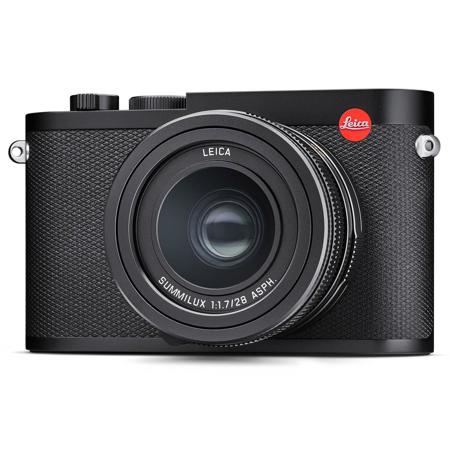 Q2 Compact Digital Camera$4995BUY NOW
Q2 Compact Digital Camera$4995BUY NOW![]()
I considered it, I am a Zeiss fan but also I have curiosity for a Schneider lenses. I have a Samsung ECX-1, the great lens is said to be a Schneider one… I think I would love to have a Xenotar version. Sadly I cannot see well, and had bad results with a camera with malfunctioning metering, so I get a Canon eos 7 with eye control. It’s a smaller format but it give me well focused photographs. But still I want a medium format TLR xD
LikeLiked by 1 person
All good things come in time my friend, I’m sure a TLR is going to come to you!
LikeLiked by 1 person
(Post-day, perhaps can help you, once I made a tutorial to post from Flickr here https://guaromekano.wordpress.com/2015/06/20/how-to-post-your-flickr-photographs-on-wordpress/ )
LikeLiked by 1 person
Sorry for the late reply and sorry I missed this. This seems like just what I needed! Gonna try to set a little time aside and try this later today. Thanks so much Francis for your kind help!!
LikeLiked by 1 person
Don’t worry, as somebody that used to post daily I understand. ^-^
LikeLike
I really, really need to spend a solid few months shooting by using my own ability to read light to set my camera’s exposure. I want to be good at that.
The only Rollei I’ve ever owned is the A110, and if there was ever an overbuilt camera for the world’s crappiest film format, that’s the one. Anyway, I’ve always wanted to test-drive a Rollei TLR; maybe one day.
LikeLiked by 1 person
ps. There is a pain-in-the-neck workaround for making your images clickable to show a larger version. Steps:
1. go to https://yourblog.wordpress.com/wp-admin/edit.php where yourblog is the name you log in with at WordPress (mine’s jimgrey)
2. find the post in the list and click Edit
3. click the image and click the pencil button
4. in the Link To box choose Media File and click Update
5. click Update in the editor
et voila
LikeLiked by 1 person
Hey Jim, thanks for this info!! Interesting, never knew about this. Might be worth a try! I’ll see I can spend a little time on this, this weekend. Thanks again so much!
LikeLike
This is the old, original WordPress post editor. It’s a hidden feature. You have to have the URL to access it!
LikeLiked by 1 person
Really appreciate it Jim, thanks a lot!!
LikeLike
Right on brother Sam. I have a 3.5F Planar and a 2.8F Xenotar. Under the right conditions, the Planar has that crispness and color subtlety like the 80mm f/2.8 T* on the Hassy. The Xenotar has a thickness to the images with character to spare. If I could only keep one, it would be the Xenotar but maybe that’s because of the 2.8 glass (and it’s a “whiteface”). If I compare all of my many shots with these two cameras, the two or three best were taken with the Planar.
I remember a number of these fine shots from other sites.
As usual, a great writeup, my talented friend!
LikeLiked by 1 person
Hey Bro, we are both lucky to enjoy such fine cameras and be a part of the cult of Rollei. These cameras give us many wonderful memories and now that the Rollei company is gone, it’s going to be folks like us who will keep the legacy alive so that everyone will remember the legend that is Rollei.
LikeLike
Could not agree more and great article! I’ve been using a Leica M2 w/ the same old 50mm Summarit forever! No meter required. I can get a general sense for the day and location and then I sort of go with my gut in terms of making my decisions shot by shot. It’s all intuitive now, as it should be.
LikeLiked by 1 person
Thanks! Awesome Leica combo you got there and yes, manual metering rocks, I think it’s just a heck of a lot more satisfying to do. Thanks again for your kind comments, appreciate it!
LikeLike
I also have a Rollei flex with serial nr 1460675(synchro compure) so a 2.8C with a Heldosmat lens 2.8/75 above , underneeth a Carl Zeiss (nr 1332545) lens tessar 1.3,5 f=75mm.I’want to sell it to an antique shop who’s specialised in paintings. How many do you think I can ask. I do no nothing about these things.Can you please advise me wich price i can ask for this camera? All elements and function buttons are working well, lenssens are clean, and i also have the original leather case as well. Can you advice me please? Thank you very much.
Bart (Belgium)…Europe.
LikeLiked by 1 person
Hi Bart, I am not sure what the prices for Rolleiflexes are in Belgium but here in the USA, your Rolleiflex would probably sell for $200-300 depending on condition. Of course, if you sell it to a dealer keep in mind they want to make a little profit so they may offer you a lower price. Hope this helps and good luck with the sale! Regards, Sam
LikeLike
“the last remnants of rollei disappeared in 2015”.
DW-Photo GmbH is the new name for the Rollei camera manufacturing company. They are still making digital medium format cameras in the same Braunschweig factory since 1929!
This is the website for the US distributor for DW-Photo GmbH
https://rolleiflex.us/blogs/news-tech-tips-updates/factory-visit-summer-2016-yes-they-are-still-in-business
Also, the Rollei brand of papers, chemistry and film has just released a new slide film called vario-chrome. http://www.thephoblographer.com/2017/06/27/new-rollei-vario-chrome-versatile-slide-film/
I kindly ask that you correct that part of your otherwise good review so that readers are not misinformed and the surviving Rollei products are acknowledged.
LikeLiked by 1 person
Thanks Justin! I’m glad to know that “Rollei” is still making cameras and film. I actually went to that site a few times before doing my review and I was under the impression that it was run by someone who bought the Rolleiflex name. I think the key words that I wrote were Rollei “as we know it” vanishing. I did make an update with the corrections and your links. I’d be very happy to see Rollei rise again, whoever runs it. Thanks very much!
LikeLike
The Exenotar lens is a planar lense. Planar refers to the design and was produced by both schneider kreuznach and Carl Zeiss. Hope this helps.
LikeLiked by 1 person